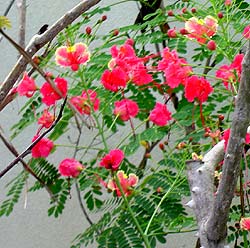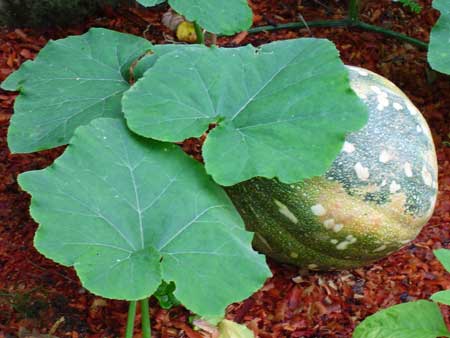| GreenGardeningCookingCuring.com | P
PAGE |
| HOME |
| Tour Our Destination Websites | Taxco-Today.com | Oaxaca-Today.com | Montserrat-Today Site |
| See our silver designs at Krika.com | Read our travel stories and other tales at Krika.com |
|
|
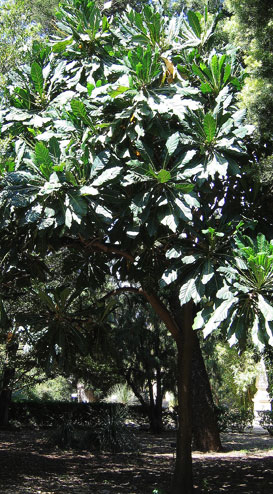  Pacific
Puka Meryta denhamii Seem. Pacific
Puka Meryta denhamii Seem.Benefits: Surprisingly, I haven't yet found any specific benefits aside from its visual appeal. From: New Caledonia and New Zealand Photographed: In the Palermo Botanical Garden in Sicily, Italy. Planting and Care: This small tree, growing only about 20 feet tall, lives naturally in dense humid frost free forests. If you can duplicate those conditions you will have a happy tree. Pacific pukas grow well in full sun or light shade, but they cannot tolerate frost. On the plus side pukas are tolerant of wind and sea air. Text and Photographs ©GreenGardeningCookingCuring.com 2012/2018 |
|||
| **Pacific Rosewood See Below -- PORTIA TREE | |||
| Palm Beachbells See the "K" Page -- KALANCHOE -- Donkey's Ears | |||
| Palm Trees and Sago Palms See the "PALMS AND SAGOS" Page | |||
 **Palm
Grass, Bristle Grass, Broadleaved Bristlegrass, Knotroot Curculigo
capitulata syn Molineria capitulata (Lour.) **Palm
Grass, Bristle Grass, Broadleaved Bristlegrass, Knotroot Curculigo
capitulata syn Molineria capitulata (Lour.)This is a strange plant to call "grass," but despite its inappropriate name it is a very appealing plant. Benefits: I didn't find any yet aside from its wonderful quality in the garden. From: India and Tropical China Photographed: At the Hotel San Buenaventura on Lake Atitlan in Guatemala. Planting and Care: Palm grass is a tropical perennial. Its 2 to 3 foot leaves resemble palm leaves, hence its name. It prefers to live in semi-shade in well-draining moist soil. palm grass Text & Photograph ©KO 2010 and ©GreenGardeningCookingCuring.com 2018 |
|||
| Palma Christi See the "C" Page -- CASTOR OIL PLANT | |||
| Panama Queen Please See the 'O' Page -- ORANGE SHRIMP PLANT | |||
 Pansies Viola
tricolor var. hortensis Pansies Viola
tricolor var. hortensisI have always loved these low growing brilliantly colored softly petaled flowers. I grew up with them in spring flower beds in New England and have only rarely seen them since then. When we got to Ushuaia, Argentina, it was the end of summer and the pansies were a little tired, but I was thrilled to see them anyway. It was particularly surprising to see them then because they were always considered "only for spring" flowers in New England. Benefits: Believe it or not, pansies are edible, both leaves and flowers, and they are also high in A and C vitamins. With pansies in your garden you get a lot of benefits for such a small and easy to care for investment. From: Europe Photographed: In Ushuaia and Calafate, Patagonia, Argentina. Planting and Care: Pansies are easy to grow and most often purchased at a flower shop as tiny plants that you can take home to enliven your springtime garden with their wonderful colors. They are pretty short, maybe about 8" tall, so they make wonderful "filler in" plants. They do best in full sun in the cooler parts of the world like New England and Patagonia and they prefer a well-draining soil. Water them occasionally if it doesn't rain often. Text and Photographs ©GreenGardeningCookingCuring.com 2012/2018 |
|||
  |
|||
  |
|||
 **Papaya
Tree, Pawpaw Carica papaya L. **Papaya
Tree, Pawpaw Carica papaya L.These are fast growing very attractive small trees that with a little luck will last for many years in a warm climate bearing lots of fruit throughout the year. The appearance and flavor of its fruits vary considerably so always try to taste a fruit before you plant its seed. Most of the papayas sold in the United States are GMO, so do look for organic papayas to get the full benefits of this fruit and to avoid allergic reactions down the road. Benefits and Cautions: If you'd like to have an all natural cosmetic 'peel', think about a mix of fresh papaya and pineapple for a great facial. Give this a quick try, maybe 5 minutes and then rinse off. Next day try it for 10 minutes if you didn't get the benefits you were looking for. Remember you are trying to improve the skin on your face, not have your face digested! Green papaya slices applied to bee or wasp stings or wounds have been said to promote healing. I haven't tried this myself, so go easy at first. Try using papaya for 5 minutes on a bee sting if you want and see how it goes. Seeds or slices of the green or ripe fruit may act as digestive aids relieving constipation, bloating and gas.My husband swears by its ability to make his tummy feel good when he has eaten something dicey. Mixed with milk, the green fruit is used in some countries to reduce high blood pressure. I don't have any personal experience with this and have no idea what the milk/papaya quantities might be. If you've heard of this, please let me know so I can share it with others. Somewhere else I read that when mixed in a juice with sour orange, papaya is believed to help reduce high blood pressure. Tea made from the leaves is said to relieve kidney disorders. Papaya may be useful in weight control,because one of its ingredients, an enzyme called papain, may help to burn calories more quickly. Papain, similar to one of our own enzymes produced in the pancreas, has long been used as a meat tenderizer and it does just that. It breaks down proteins. On the down side, if you are peeling or slicing papayas frequently or in quantity, it can easily break down the skin on your hands; wear rubber gloves for protection. Papayas are also high in Vitamins C and A. From: Tropical Americas, from Mexico through Latin America. Photographed: On the left above at the top of our terrace garden at our former home in Montserrat. Below in a neighbor's garden at Lake Atitlan in Guatemala. Planting and Care: My best advice for planting a papaya is to take the seeds from a fruit you particularly liked eating and toss them on good garden soil. Then wait. Once the seeds take, in about four to eight weeks, papaya trees are incredibly fast growing and will provide fruit in their first year. If you buy or are given a papaya tree, plant it in a hole 18" deep with lots of manure and hope for the best. We never had any luck planting a tree, but lots of luck with casually strewn seeds. The papaya is an enormously productive tree and its fruits, whether green or ripe yellow, have many uses. Papayas are male or female trees and you need to have one of each to get fruit. The male tree can be identified more quickly than the female as it produces flowers when it is still pretty immature. Even so, you'll still have to wait a few months to see if you have male or female plants. You will need only one male plant so extras can be discarded unless you have lots of room and a particular fondness for them. Papayas like to grow in full sun with regular rainfall or watering and a monthly dose of fertilizer, but they are adaptable within limits. Text and Photographs ©KO 2008/2010 and GreenGardeningCookingCuring.com 2013/2018 |
|||
 |
|||
| Parasol Flower See The "C" Page -- CHINESE HAT | |||
| Parlor Ivy See the "G" Page -- GERMAN IVY | |||
| Parrot
Plant Impatiens niamniamensis From: Tropical East Africa Photographed: On the left in the Botanical Garden at the Hotel Atitlan on Lake Atitlan in Guatemala and on the right in the Royal Botanic Garden in Sydney, Australia, in 2013. Planting and Care: This is a low growing half to full shade loving plant. It has lovely flowers almost continuously if it also receives routine rainfall or watering. Happily for some, the plant also likes an acid soil. Text and Photographs ©KO 2010 and ©GreenGardeningCookingCuring.com 2018 |
|||
 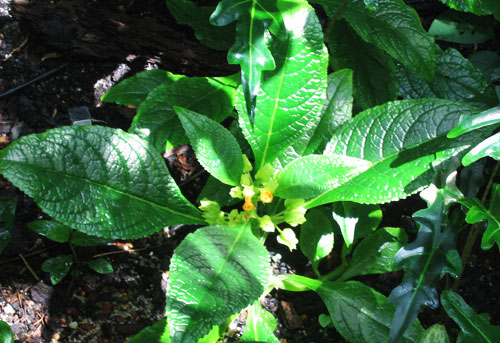 |
|||
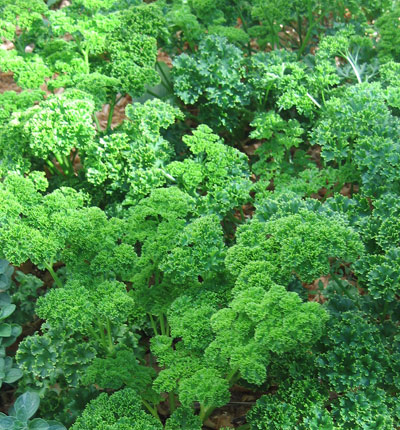 **Curly
Leaf Parsley Petroselinum crispum **Curly
Leaf Parsley Petroselinum crispumParsley is one of those garden essentials that can almost be taken for granted. We use it in every way imaginable every day. It grows like a weed and seems to have few garden enemies even in the Caribbean where that is rarely the case. This is a perfect plant to grow organically. Benefits: Used fresh the curly variety is high in amino acids, aspartic and glutamine, and also rich in vitamins and minerals. The Chinese believe that parsley, which is loaded with luteolin, is a very beneficial in alleviating disorders of the eyes. From: The central Mediterranean. Photographed: In our garden at Lake Atitlan in Guatemala. Planting and Care: See below, flat leaf parsley Variety I've Planted: "Forest Green" I found this parsley to be especially wonderful in the highlands of Guatemala. It grew like a weed. We used it in almost everything we cooked and fresh in salad and in dozens of other ways. Text and Photograph ©GreenGardeningCookingCuring.com 2013/2018 |
|||
| **Flat
Leaf Parsley, Italian Parsley, Chervil Herb Petroselinum
neapolitanum First lost to the volcanic eruption in July of 2003, we replanted this most essential herb many times, both in the garden and in pots by the terrace. Benefits: The flat leaved Italian variety is more chic these days. Either one is delicious and can be used liberally every day in every way! Photographed: Below on the left are the little plants I grew from seed that were ready to be planted in our herb garden at our former home in Montserrat. Planting and Care: In a tropical environment, plant parsley in moist well-drained soil and fertilize it regularly. In the Caribbean, flat leaved Italian parsley and frilly leaved parsley both seem to prefer semi-shade to full sun to thrive. Overall the flat leaved variety wins my vote as it was always much healthier than the curly variety in the Caribbean. On our terrace garden in Taxco, Mexico, we were able to keep our potted frilly parsley plant alive and thriving for at least four years. In Montserrat, parsley plants are viable for no more than one year; more often than not, six months is the limit. In the environment at Lake Atitlan in Guatemala, our frilly parsley has been thriving for almost a year. The plant is said to be a biennial so I have my fingers crossed. Text and Photographs ©Krika.com 2008 and ©GreenGardeningCookingCuring.com 2013/2018 |
|||
  |
|||
| **Pawpaw See Papaya Above | |||
| **Peace Lily See The "S" Page -- SPATHIPHYLLUM | |||
 **Peanuts,
Groundnuts Arachis hypogaea L. **Peanuts,
Groundnuts Arachis hypogaea L.A few years ago I planted some peanuts just to see what happened. As it turned out peanuts are beautiful plants that produce tiny yellow orchid like flowers; they would find a welcome place in any tropical flower garden especially used as a border planting. There are two types of peanuts. The erect type has upright stems which is what we have grown (remember the seeds come from the supermarket). Prostrate peanut stems grow on the ground and have the advantage of a higher yield with all peanuts ripening at the same time. This is the one to plant if you are commercially minded about your peanut crop. Benefits and Risks: Peanut butter and jelly sandwiches were a staple children's food when I was growing up and I never lost my taste for them. Sadly, it seems something has been done to commercially grown peanuts in the States because I now have an allergic reaction to US produced peanut butter. Maybe they've been genetically modified or maybe it is something else, but it seems fewer and fewer people are able to eat peanut butter so the health benefits of eating peanuts is meaningless. Thanks Monsanto, I can no longer eat a food I have loved for 50 years. From: Peanuts are native to Brazil. Harvesting: About five months from the date of planting, the leaves of the peanut plants will begin to turn yellow -- this is the time to harvest. Dry the plants with the peanuts still attached to the roots for two to three days before shelling and eating the fresh peanuts. Ideally you should get about forty peanuts per plant. We've never done that well, but then we aren't Jimmy Carter! Photographed: In our upper garden at our former home in Montserrat. Planting and Care: 1. First buy some unroasted organically grown peanuts. If they are fresh and taste good, husk them removing the papery seed covering. In your garden, plant each peanut about two to four inches deep and about four to six inches apart in the row with rows about three feet apart. 2. In a few weeks the plants will be up and you can thin them to about one foot apart in the row (if you are determined to have lots of garden grown peanuts). I leave them at four inches and still enjoy pulling up the plants and finding -- PEANUTS! And, I especially enjoy having a row of such beautiful plants. 3. Peanuts prefer to grow in full sun, but will tolerate a little shade. They like a fertile sandy or loose soil with a pH of about 6 if they can have it and regular rainfall or watering. Boron is one of the very necessary components of good peanut growing soil and we were fortunate in Montserrat to have the active Soufriere Hills Volcano producing the boron so essential to peanut plants. 4. Your peanut bed should be moved after two years to somewhere new in your garden. Text and Photograph ©KO 2008 and ©GreenGardeningCookingCuring.com 2013/2018 |
|||
| **Pear See The "A" Page AVOCADO | |||
| Peas Pisum
sativum This is one vegetable I had no luck growing in the Caribbean and it wasn't for lack of effort. Maybe it was just too hot. But, if you live in a northern cool climate, don't be dismayed. In those conditions, I used fresh peas from the garden in salads and in too many ways cooked that I can't even count. They are wonderful. Text ©KO 2007 and ©GreenGardeningCookingCuring.com 2018 |
|||
| Pecans Benefits: Nuts have over the years faded in and out of popularity among nutritionists, but one has to admit nuts have been a staple in the human diet for thousands of years and that can't be an accident. They taste wonderful and they are good for us. Pecans are especially good for us because they are an excellent source of Vitamin E. Text ©KO 2007 |
|||
| **Pentas,
Egyptian Star, Star Cluster Pentas lanceolata Our lavender pentas arrived in our deck garden on their own and did well enough with no help that I thought I was dealing with an attractive weed. As it turns out pentas are tough perennials. They have long lasting blooming periods with red, pink, or lavender flowers as you can see below. Benefits: Pentas flowers attract bees, butterflies and birds. In traditional medicine pentas roots, leaves, and flowers have been used to treat fairly serious health problems. From: Tropical and southern Africa. Photographed: In our deck garden at our former home in Montserrat in the Caribbean and at Hotel San Buenaventura in Panajachel, Guatemala. Planting and Care: Pentas are said to prefer a sunny location, but I have seen lovely ones growing happily in semi-shade. Watering doesn't seem to be much of an issue aside from reasonably regular rainfall. Text and Photographs ©KO 2010/2018 |
|||
|
|||
 **Peony Paeonia
officinalis **Peony Paeonia
officinalisThis is just about my favorite flower in the whole world. Its scent is heavenly. Be sure when you buy peonies for your garden to get the old varieties as they are the ones with scent. I found myself heartbroken when I saw a friend's elaborate garden in New Hampshire planted with peonies that had no scent at all. Benefits: It has been said that the medicinal benefits of the peony have been in use in Europe for over 2000 years. From: France, Switzerland and Italy. Photographed: In the Ortobotanico (Botanical Garden) in Naples, Italy, in 2013. Planting and Care: Peonies are shrubby plants that in my experience reached a height of between 2 and 3 feet with a spread of about the same size. They have soft leaf-bearing stems which thrive all summer long and more erect tougher flower stems that begin to appear in May and last maybe a month and a half. They are perennials that do well in cooler climates planted in full sun in fertile, rich soil with a relatively neutral pH. Most important for lots of beautiful flowers is to plant your peony in full sun away from any competition. I planted mine in the middle of a 4 foot border garden with 2 feet on either side and surrounded them with ever blooming California poppies. Text and Photograph ©GreenGardeningCookingCuring.com 2013/2018 |
|||
Peppermint,
Candymint |
|||
**Pergrina -- Please See the "J" Page -- JATROPHA |
|||
Pericón,
Sweet Scented Marigold, Mexican Marigold, Mexican Mint Marigold,
Mexican Tarragon, Spanish Tarragon Tagetes
lucida Cav. |
|||
 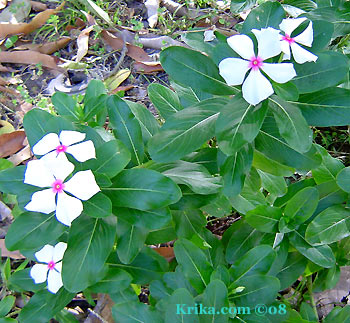 **Periwinkle Catharanthus
roseus **Periwinkle Catharanthus
roseusOur periwinkles in Montserrat were lost to the volcanic eruption of July 2003, but not long after, tiny periwinkle plants began appearing all over our garden. It is a friendly looking plant, not at all exotic, with small lilac, pink or white flowers. It fills in all by itself here and there around the yard. Benefits: Aside from being used as a treatment for high blood pressure, its leaves were a Carib curative for diabetes. This unassuming plant also produces vinblastine, a component of a drug used in the treatment of Hodgkin's disease and vincristine which has proven beneficial in the treatment of leukemia. From: Madagascar Photographed: The two photographs on the left and right were taken in brighter parts of our shady terrace garden at our former home in Montserrat, in about 2008. We encountered it again on a visit to Viscaya in Miami and you'll see that plant in a photograph below. Planting and Care: Periwinkles will grow just fine in the sun or in the shade as long as they receive some very occasional rainfall or watering and a once in a while dose of fertilizer. Text and Photographs ©KO 2008/2010 and GreenGardeningCookingCuring.com 2014/2018 |
|||
Photographed: In
the garden at Viscaya in Miami, Florida, in
2014. |
|||
Photographed: In the garden at the Sonesta Hotel in Osorno, Chile, in 2019.
|
|||
| Purslane See the "M" Page -- MEXICAN PURSLANE | |||
| Peruvian Apple See the "CACTUS" Page -- APPLE CACTUS | |||
  Peruvian
Lily, Lily of the Incas Alstroemeria
psittacina Peruvian
Lily, Lily of the Incas Alstroemeria
psittacinaThese are very popular brightly and delicately colored long lasting cut flowers. Benefits: From: South America Photographed: At the Hotel Atitlan on Lake Atitlan in Guatemala. Planting and Care: These lovely plants are perennial only in places where there is not a hard winter. In cooler climates, dig them up in the fall giving them a good cleaning and store in a dry mix of soil and peat moss until they can be planted again when summer approaches. Peruvian lilies in your garden should be given a good amount of space which they will quickly occupy. When mature they will be about 4 feet high and half as wide. Plant your Peruvian lilies in rich well-draining soil in a place in the garden that receives morning sun and, if you're in a hot climate, do keep them in a spot where they will not have to suffer the hottest afternoon sun. Water them frequently if it doesn't rain, but take care not to over water. Text and Photographs ©KO 2010 and ©GreenGardeningCookingCuring.com 2018 |
|||
  |
|||
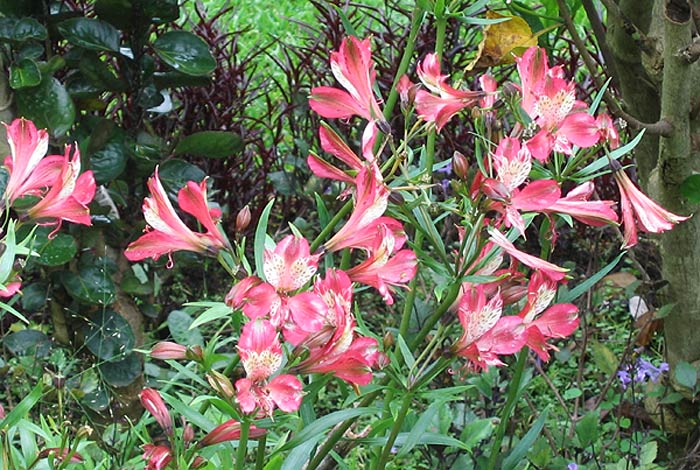 |
|||
SAFE PESTICIDES FOR ORGANIC GARDENING IN THE TROPICS AND ELSEWHERE There are a variety of natural organic pesticides available to gardeners who do not wish to use more commercial and more dangerous insecticides. This is not to say that because something is organic that its use presents no risks. Below are listed a few of the organic materials I have come across over the years. Barbasco
Root Lonchocarpus nicou Neem
Tree Products Pyrethrum Rotenone Soap 2. Mix
1 tablespoon of dishwashing liquid and 1 cup of vegetable oil and
use 1 tablespoon of the mixture in 1 cup of water. TREATING PLANT DISEASES Powdery
Mildew 1. Mix and then shake the following ingredients well and spray
your plants top and bottom in the late afternoon. 2. Mix
and then shake the following ingredients well and spray your
plants top and bottom in the late afternoon. 3. Mix 1 part milk and 9 parts water and spray affected plants 4. Mix 1 teaspoon baking soda and 1 quart water and spray affected plants COMMERCIAL PESTICIDES TO ESPECIALLY AVOID Anything produced by Monsanto, Bayer, Syngenta or Dow, but especially any and all commercial weed killers. Malathion,
learn why at:
Also See The "L" Page: |
|||
Philippine
Orchid, Showy Medinilla, Rose Grape, Malaysian Orchid Medinilla
magnifica This Flower Mystery was solved by Ursula G. living in Southern Germany |
|||
  |
|||
** Phlox Phlox
paniculata Phlox Phlox
paniculata This is a very old, sweet smelling lovely flowering plant found in absolutely every one of the best gardens in New England (at least when I was a child). Benefits: Aside from their delightful appearance in the garden, phlox are said to have been used in traditional medicine for a variety of ailments. From: Cooler climates in America. Photographed: In the Botanic Garden in Wellington, New Zealand, at the Hotel Atitlan on Lake Atitlan in Guatemala and at the Thuya Garden on Mt. Desert Island in Maine. Planting and Care: Phlox is a perennial liking sun and a reasonable amount of rainfall or routine watering. It is best to keep water off the leaves when you can because the downside to this plant is its susceptibility to downy mildew. It is very winter hardy, but does not require a period of deep cold each year as do some plants like rhubarb. Text and Photographs ©GreenGardeningCookingCuring.com 2013/2018 |
|||
 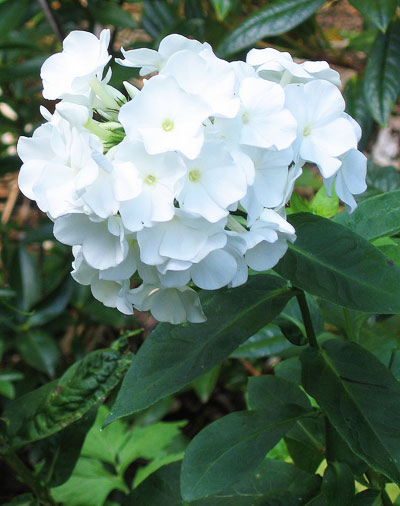 |
|||
  |
|||
 Pigeon
Pea, Dhal, Red Gram Cajanus cajan syn. Cajanus
indicus Pigeon
Pea, Dhal, Red Gram Cajanus cajan syn. Cajanus
indicusPigeon peas are a hot climate agricultural alternative to green peas which will not produce food in a hot climate. Benefits: The mature seeds of the pigeon pea is an ideal vegan food, supplying high levels of nutrients especially protein. It will grow in the hot and dry conditions that are becoming all too common and it seems resistant to many potential insect predators and plant diseases. As well, many cultures around the world use parts of these plants in traditional medicinal curatives. From: The pigeon pea is known to have been growing in the Indian sub-continent 3500 years ago. Photographed: To the left, a young plant just below our deck garden at our former home in Montserrat. Below I took a photograph of a mature plant and a detail of the peas also in Montserrat in our upper terrace garden Planting and Growth: This perennial plant is ideally suited to the Caribbean summer environment -- hot and dry. It is very adaptable to soil conditions growing well in acidic or sweet soils. Plant it in full sun or with a little shade and it will do just fine producing lots of pigeon pea pods to keep you busy shucking peas while chatting with friends in the evening. We spent many an evening this way with friends in Tobago and with not a few rum and cokes. Text and Photographs ©krika.com 2009 and ©GreenGardeningCookingCuring.com 2012/2018. |
|||
  |
|||
| Pigsqueak Bergenia
cordifolia This is a lovely foliage plant especially since it will thrive in shady conditions. Best of all it has very sweet blossoms in the spring. It will grow to be about 12 inches high and equally as wide. Benefits: The Bergenia family of plants have several traditional health benefits. From: Russia Photographed: Below on the left at the Sonesta Hotel in Osorno, Chile in 2019 and at the Hotel Atitlan on Lake Atitlan in Guatemala in 2010. Planting and Care: This plant prefers a semi shady or shady place in the garden in an area that is usually moist and has woodsy soil. It is easy to care for and once settled in, it is tolerant of some mistreatment by nature or even by us. Text and Photograph ©GreenGardeningCookingCuring.com 2013/2018 |
|||
  |
|||
|
|||
| Pine Cone Ginger See the "G" Page GINGERS -- Pine Cone Ginger | |||
  **Pink
Cassia Tree, Pink Shower Tree, Yellow Shower Tree Cassia
grandis L. if. or Cassia javanica (pink)
or Cassia fistula (yellow) **Pink
Cassia Tree, Pink Shower Tree, Yellow Shower Tree Cassia
grandis L. if. or Cassia javanica (pink)
or Cassia fistula (yellow)The pink cassia tree is beautiful with its lush covering of long lasting luscious pink flowers. Benefits: Its attractive long and round very dark brown seed pods provide a pulp that is said to act as a laxative. From: It is originally from Java Photographed: The pink flowers to the right and left were photographed in our garden at our former home in Montserrat. The pink flowers and trees below were photographed in Tobago in 2018. Planting and Care: The cassia usually grows to about thirty feet tall and normally blooms in Montserrat in May. Sadly, we had to cut ours down and have it removed because it had been so ravaged by termites. The tree stump left was only about a foot high, but branches soon began growing sideways from the stump. It looked like a very bizarre bush as the branches extended about ten to twelve feet from the two foot high stump. We had the space for it and we had the guilt to deal with it so we let it grow. But, we had planted a Mexican lime tree nearby and as the Cassia grew it invaded the lime tree's space. Even when I cut branches from the cassia that were touching the lime tree, within a few days more cassia branches would be touching the lime tree. They were definitely not friends. So....the cassia had to go as we were desperate to have fresh limes on an island once known for it's lime juice preventing scurvy in the British navy. What was especially good news is that there was a small volunteer cassia growing in our hedge garden. We transplanted it and it is off and running. Text & Photographs ©KO 2008/2010 and ©GreenGardeningCookingCuring.com 2018 |
|||
 |
|||
  |
|||
| To See Yellow Cassia Trees Please Click here | |||
Pink
Trumpet Tree, Pink Poui, Pink Tecoma, Rosy Trumpet Tree,
Savannah Oak Tabebuia rosea To see the Yellow Poui Trees in our former garden in Montserrat, please click here They were glorious! My #4 Tree Mystery was solved by Glenn a visitor to my website who lives in Brisbane, Australia. Many thanks for your help. |
|||
  |
|||
Tree
Mystery solved by Ursula G. living in Southern Germany |
|||
 |
|||
  |
|||
 |
|||
| Pink Shower Tree -- See The Pink Cassia Tree Above | |||
| **Pink
Trumpet Vine, Port Saint John's Creeper, Port Saint John's Klimop Podranea ricasoliana This is a very hardy vine with delightfully delicate pink flowers seemingly all the time. It is not the most showy or extravagant of flowering vines, but it surely has a place in any garden needing a resilient non-clinging vine. As a vine, its advantage is that it doesn't have clinging tendrils so it will grow where you put it and depend on you for where to go from there. Benefits: I didn't find any references to its benefits except its appeal as an ornamental. From: South Africa Photographed: In our garden in Panajachel at Lake Atitlan in Guatemala. Planting and Care: This is a warm climate plant that will live in the most southern parts of the US as a perennial in your garden. It can be planted in containers, but that doesn't seem to be the best home for Podranea ricasoliana. It prefers to be set in rich soil that has a higher than normal amount of sand to ensure that it is well aerated. Mine did fine in a mixture of sharp sand and composted soil mixed about 50/50. Find a place in your garden with an existing support for the vine that will give you the most flowers when planted in full sun. It will need routine rainfall or watering when the top inch or so of soil is dry. Text and Photographs ©GreenGardeningCookingCuring.com 2013/2018 |
|||
  |
|||
Pistachios Pistacia vera Take a tour of Sicily where the best pistachio gelato in the world is made. http://krika.com/STORIES%20ITALY/SSICILY1.html |
|||
Pithy Thai Dragon See the "H" Page -- HYLOCEREUS UNDATUS |
|||
TO
SEE PLAINTAINS -- PLEASE Click
Here to See the Bananas and Plantains Page |
|||
| Plum Rose See the "R" Page -- ROSE APPLE | |||
| Poison
Arrow Plant, Bushmen's Poison, Dune Poison-Bush Acokanthera
oblongfolia Hochst.
Codd This is an attractive flowering bush that when I took these photographs had begun to fade from glory. I couldn't resist including it here with so many of my favorites, but I do not recommend planting it. Benefits: Parts of this plant have been used in traditional medicine in the treatment of poisonous snake and spider bites. From: Africa Photographed: In the Naples, Italy, Botanical Garden 2012. Planting and Care: I do not recommend planting this bush or small tree. Warning: Acokanthera oblongfolia Hochst. Codd is a deadly poisonous plant "which can kill within minutes when ingested or when sap enters into the blood stream. All parts of this tree are toxic including the fruit, especially when it is unripe." Text & Photographs ©GreenGardeningCookingCuring.com 2012/2018 |
|||
  |
|||
**Pok
Choy Vegetable Brassica
rapa |
|||
  Photographed: To
the left in our semi-shady herb garden at our former home in Montserrat.
On the right in our garden at Lake Atitlan in Guatemala in 2015. Photographed: To
the left in our semi-shady herb garden at our former home in Montserrat.
On the right in our garden at Lake Atitlan in Guatemala in 2015. |
|||
 Pokeweed,
'Ushgush' Phytolacca
americana Pokeweed,
'Ushgush' Phytolacca
americanaThis was a wild plant in my childhood, one we enjoyed arming ourselves with for our hysterically funny child wars. During its ripening fruit season we regularly arrived home almost unrecognizable with purple clothing and purple skin. It must have driven our mothers mad, but the memory of this period of childhood remains one of my fondest. I have to confess on our recent visit to New England I spotted 'ushgush' one day and confess it was only my adult 'restraint' that stopped me from starting an ushgush war with my beloved and equally foolish husband. Benefits: Children love it! And, Wikipedia has this to say about it, "...some parts can be used as food, medicine, or poison if properly prepared." From: The eastern areas of North America Photographed: In the Botanical Garden in Naples, Italy, in 2014. Planting and Care: I wouldn't recommend it if there are children in your area. Text and Photographs ©GreenGardeningCookingCuring.com 2015/2018 |
|||
 |
|||
 **Polka
Dot Plant, Freckle Face Plant Hypoestes phyllostachya
syn. Hypoestes sanguinolenta **Polka
Dot Plant, Freckle Face Plant Hypoestes phyllostachya
syn. Hypoestes sanguinolentaThis is a colorful addition to a bright shade garden and the plants come in pink, white and red spots to suit all tastes. Benefits: On a recent search (10/9/2018) I didn't find anything useful on Google. From: Madagascar Photographed: At the Hotel Atitlan on Lake Atitlan in Guatemala in 2010. Planting and Care: These low growing tropical shade plants are hearty, but do require moist fertile well-drained composted soil and humidity in the air to be at their best. Their color will be enhanced by lower light which is an unusual benefit to folks with shady gardens. Text & Photographs ©KO 2010 and ©GreenGardeningCookingCuring.com 2018 |
|||
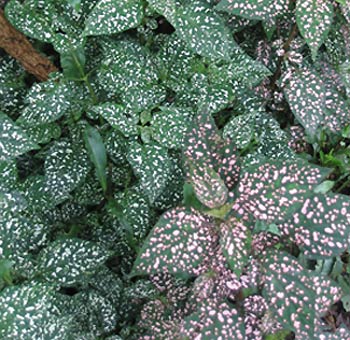  |
|||
  |
|||
| **Pomegranate
Tree Punica granatum The pomegranate is a wonderfully exotic fruit that is not only beautiful, but tastes good too. I had my first experience with them when in college in Boston, Massachusetts. Back in those days there was a fabulous food market just behind Beacon Hill where you could buy whatever you desired from fruit and vegetables to meat and fish. At Christmas time it was also a place to get your tree and garlands of natural greens. The fruit of the pomegranate tree is split open revealing seeds with a lovely red crisp jelly like coating. Take a bite, enjoy the coating and spit out the seeds. Benefits: The pomegranate is said to improve circulation and to be not only an especially powerful antioxidant, but a builder of red blood cells too. Grenadine, at least the real thing, is made from pomegranates and helps to make a truly memorable tequila sunrise! From: Southern Asia Planting and Growth: Plant your pomegranate tree in full sun in a warm climate in an area that is naturally a little dry. It is a lovely tree and apart from giving us its glorious fruits it has very appealing red flowers. Text and Photographs ©Krika.com 2008/2010 and GreenGardeningCookingCuring.com 2015/2018 |
|||
  Photographed: On
the left at a neighbor's home in Montserrat. On the right in
the (Ortobotanico) Botanical Garden in Naples, Italy,
in 2014. Photographed: On
the left at a neighbor's home in Montserrat. On the right in
the (Ortobotanico) Botanical Garden in Naples, Italy,
in 2014. |
|||
| Ponytail Palm -- See the Palms and Sagos Page | |||
 Breadseed
Poppy, Opium Poppy Papaver Somniferum Breadseed
Poppy, Opium Poppy Papaver SomniferumThis beautiful flower seemed to be an escapee or a volunteer in the sunny woodsy area in the Palermo Botanical Garden (Ortobotanico). Its lavender flowers and gray green foliage seemed almost too perfect. Benefits: Poppies of all kinds seem especially delightful to me, and this one is said to have beneficial health effects in traditional medicine. It is also an attractant for birds, butterflies and bees so what could be better? Most importantly these days is the role it plays in the production of illegal opium and heroin and pharmaceutical opioides. From: The eastern Mediterranean Photographed: In the Palermo Botanical Garden in Sicily, Italy. Planting and Care: Papaver somniferum is an annual, but its prolific seed production leads it to be considered a perennial. The plant will grow to be about 2 feet tall with its attractive gray/green foliage and 2 to 4 inch blossoms making it a showpiece in any garden. Text and Photograph ©GreenGardeningCookingCuring.com 2012/2018 |
|||
 **California
Poppy, Golden Poppy, Flame Flower, Cup of
Gold Eschscholzia californica **California
Poppy, Golden Poppy, Flame Flower, Cup of
Gold Eschscholzia californicaThis is one of the smaller continuously blooming poppy varieties and it is one of my favorites. In Montserrat I tried several times to get it past the young, just germinated, phase and it never made it. I read that they will grow in "poor, but well drained soil" which we had plenty of, but I didn't find it to be so. I am tried again at our home at Lake Atitlan in Guatemala where I have also had no luck. Benefits: California Poppies are edible and an appealing way to enliven salads or decorate dinners and desserts. From: Mexico and the United States Photographed: In the Coastal Maine Botanical Gardens, Boothbay Maine, in 2013. Planting and Care: Eschscholzia californica is a pretty hardy perennial plant which I first encountered as a young woman in the garden of my home by the sea in southern New England. It grew in a wide garden bed with mature peony bushes and irises decorating the whole bed when the larger plants had passed their flowering period. I loved it then and still do. It has buttercup like flowers on feathery gray/green foliage and it proved to be very resilient and easy to care for. Sow your seeds in a garden area with full sun with rich, sandy, well-drained soil. Rainfall should take care of water requirements, but do water the plants when the soil dries out. Text and photograph ©KO 2008 and ©GreenGardeningCookingCuring.com 2013/2018 |
|||
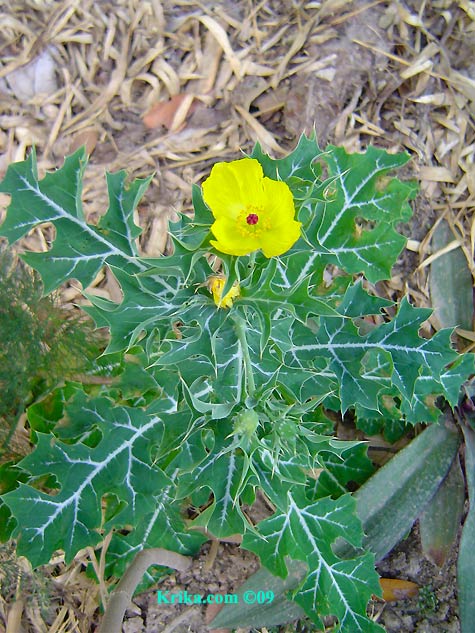 **Mexican
Poppy, Yellow Thistle, Yellow Poppy, Mexican Thistle, Goatweed Argeemone
mexicana **Mexican
Poppy, Yellow Thistle, Yellow Poppy, Mexican Thistle, Goatweed Argeemone
mexicanaThis plant was a gift of the winds as it simply appeared one day in our deck garden. I left it to grow as I always do with anything I don't know and was very happy when it matured. It is said to be an annual that will flower in the spring and summer and that seemed accurate. Benefits: As with many traditional herbal remedies, this plant has both healing and toxifying qualities. It was used extensively by the Sonoran Indians of Mexico. From: Mexico and the Caribbean Photographed: In our deck garden at our former home in Montserrat. Planting and growth: I'd have to say this is one of those survivor plants that are lovely to have in any large garden or for those who do not have a green thumb. It is tolerant of a wide range of soil types and levels of moisture, but it does seem to prefer a sunny spot in the garden. Warning: This plant may be considered toxic. Text and Photograph ©Krika.com 2009/2010 and ©GreenGardeningCookingCuring.com 2018 |
|||
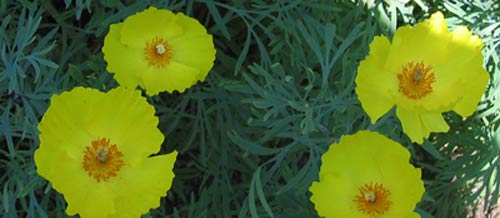 Mexican
Tulip Poppy 'Sunlight', Mexican Sun Poppy, Mexican Prickly Poppy Hunnemannia
fumariifolia Mexican
Tulip Poppy 'Sunlight', Mexican Sun Poppy, Mexican Prickly Poppy Hunnemannia
fumariifolia This is a perennial poppy which adjusts well to rocky relatively inhospitable places. Its flowers are bountiful and very appealing with foliage closely resembling that of the California poppy. Benefits: Nothing I found mentioned benefits aside from just how lovely it is. From: The Mexican highlands at about a mile high in the Chihuahuan Desert from northern Mexico into southern Arizona and Texas. Photographed: In the Thuya Garden, Mt. Desert Island, Maine, 2013. Planting and Care: Plant this little beauty in full sun in one of the drier areas of your garden. It is used to living in difficult circumstances and will happily do so once it is established. With little or no care it will reach a mature height of about 2 feet. Text and Photograph ©GreenGardeningCookingCuring.com 2013/2018 |
|||
 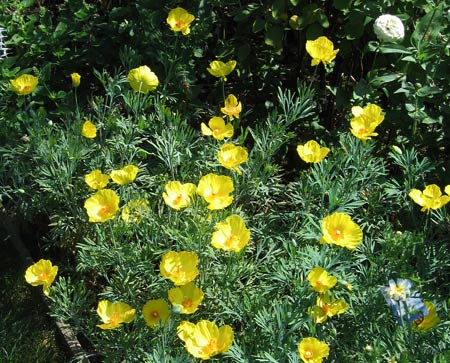 |
|||
| **Yellow Poppy -- See above "Mexican Poppy" | |||
 Yellow
Horn Poppy, Yellow Horned Poppy, Sea-Poppy, Horned-Poppy, Rhodes
Poppy Glaucium
flavum Yellow
Horn Poppy, Yellow Horned Poppy, Sea-Poppy, Horned-Poppy, Rhodes
Poppy Glaucium
flavumThis is a seaside plant pretty much exclusively living by the water. Benefits: As with other poppies this has been used extensively in traditional medicine even though it is very toxic. From: Just about everywhere from Europe and North Africa all the way to western Asia in temperate climate seaside environments. Photographed: In the Ortobotanico in Naples, Italy, 2012 Planting and Care: This poppy has gray/green leaves that are relatively thick and almost leathery. When mature it will reach a height of about 3 feet with flowers that are about 3 inches in diameter so it is one of the showier poppies. Glaucium flavum, once established, grows with little or nothing but a view of the sea. Just about everywhere I looked I found references to what requirements these plants have, but nothing on getting them started as seeds. Apparently it will grow in almost any soil, with any pH, as long as it is in full sun and is never over watered as its view of the sea seems to be enough sustenance. Warning: All parts of this plant are considered poisonous. Photograph and Text ©GreenGardeningCookingCuring.com 2012/2018 |
|||
 **Portia
Tree, Indian Tulip Tree, Pacific Rosewood, Seaside Mahoe Thespesia
papulnea **Portia
Tree, Indian Tulip Tree, Pacific Rosewood, Seaside Mahoe Thespesia
papulneaThis is a relatively small tree with deep green heart shaped leaves, interesting yellow flowers and visually appealing fruits, although I can't imagine making a pie with them. Growing only to about forty feet, it won its place in our Montserrat garden. When we bought our property this tree had been butchered with a machete or what is known in the Caribbean as a cutlass. Its main stem had been cut and its side shoots had become solid four inch thick upward reaching stems. In truth, the first time I saw the tree it looked like a very tall bush. I had committed to leaving in place anything that I couldn't identify until I learned more and this tree was one of the garden's survivors. Benefits: If you were to get very hungry, its new leaves, flowers and golf ball sized bright green fruits are all edible. Probably more appealingly, it is prized for the lovely colors of its wood. And, if that is not enough, portia's bark, fruit and roots are all said to have medicinal benefits. From: Tropical coastal places around the world. Photographed: On the side end of our property in Montserrat and in the Botanical Garden at the Hotel Atitlan on Lake Atitlan in Guatemala. Planting and Care: Although the portia is said to be native to mangrove swamps and should require lots of water, in Montserrat ours lived just fine on the dry end of our garden in full sun. It prefers a pH of from 5.5 to 6.5. One peculiar feature it has is that it attracts a relative of the cotton stainer bugs that feed on a similar type of tree, the sea hibiscus. The portia's bugs are red and black and seem always to be mating, reminding us of the 'love bugs' in the New Orleans area woods where we camped for a week or two. Links: http://www.naturia.per.sg/buloh/plants/portia.htm Text and Photographs ©Krika 2008/2010 and ©GreenGardeningCookingCuring.com 2018 |
|||
  |
|||
PORTULACA |
|||
| Portulaca,
Moss Rose Purslane, Ten O'Clock, Mexican Rose, Vietnam Rose,
Sun Rose, Rock Rose Portulaca
grandiflora This is a delightful, tough, ground-hugging flowering plant with pine needle like leaves. It can handle full sun and comes with flowers in a range of bright Mexican colors. Benefits: Portulaca grandiflora is a plant with a multitude of medicinal applications when taken both internally and externally. Unlike many other medicinal plants it is considered edible -- leaves, roots and seeds. From: Southern Brazil, Uruguay and northern Argentina Photographed: Below on the left by the roadside on Mt. Desert Island in Maine in 2013 and on the right by the shore of Lake Atitlan in Guatemala. Planting and Care: Planted in poor soil in bright sun, with regular ground level watering these annual plants will be looking good and in full flower. They are also drought tolerant which is a real plus. Text and Photographs ©KO 2010 and ©GreenGardeningCookingCuring.com 2018 |
|||
  |
|||
| Portulaca,
Common Purslane, Verdolaga, Red Root, Pursley Portulaca
oleracea This is another delightful, tough, ground-hugging, fleshy, round-leaved, flowering, succulent ground cover. It can handle full sun and comes with flowers in a range of bright Mexican colors. Benefits: All parts of the above ground plant are edible raw in salads or cooked. For other plants Portulaca oleracea is a dream companion as it is able to send its roots deep into hard soils that other plants would forsake. For your health, this is a dream plant for everyone except those with kidney disease. From: This is a plant that almost defies the definition of being 'native to.' It has been recorded in history predating Christianity by 1000's of years. Photographed: On the shore of Lake Atitlan in Guatemala. Planting and Care: Planted in poor soil in bright sun, with regular ground level watering these plants will be looking good and in full flower. They are also drought tolerant which is a real plus. Text and Photographs ©KO 2010 and ©GreenGardeningCookingCuring.com 2018 |
|||
 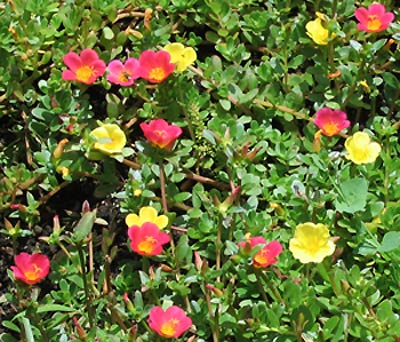 |
|||
| Potassium This is one of those absolutely necessary components in your food and gratefully it's plentiful in fresh foods. It is not something to worry about unless you dine frequently at fast food restaurants. If you do, I wish you well because you have a lot of serious issues. |
|||
**Potato Solanum
tuberosum |
|||
| **Pothos,
Devil's Ivy, Silver Vine, Golden Pothos, Ceylon Creeper,
Money Plant, Solomon Islands Ivy, Taro Vine Epipremnum
aureum This is the popular hanging plant with green and white leaves that so many of us have had in our shady windows up north. It is similar to a philodendron, but more attractive and just as easy to care for. In Montserrat pothos appears just as it does in New England until it finds something to grow on. Then it becomes an entirely different animal. The leaves grow to more than 12 inches wide and the vine that supports the leaves will be an inch or more thick. Benefits: This is plant that will help to clean your indoor environment of of chemicals such as formaldehyde, trichloroethene, toluene, xylene, and benzene. From: S.E. Asia and Moorea Photographed: At the back our our property in Montserrat. Planting and Care: Epipremnum aureum is extremely hardy and, though it prefers morning sun, it will grow in low light as well. When mature in a tropical setting it will reach a length of 1300 feet. In your home it will thrive with little or no care if planted in a good quality potting soil, watered when dry and hung in a pot in a bright light window. Warning: Despite its benefits in cleaning your indoor environment of toxic chemicals, pothos itself is considered toxic to both animals and humans. Text and Photographs ©Krika.com 2008/2010 and ©GreenGardeningCookingCuring.com 2018 |
|||
  |
|||
| **Poui Tree See The "Y" Page -- YELLOW POUI TREE | |||
 **Prayer
Plant Maranta **Prayer
Plant MarantaThis is a very common easy to care for cold climate indoor plant. In warm climates it is a wonderful, easy to grow, shady garden, ground cover. Benefits: From: Tropical areas of Central and South America and the West Indies Photographed: To the left at the Winter Garden in Auckland, New Zealand, in 2013 and below at the Royal Botanic Garden in Sydney, Australia, in 2013. Planting and Care: Prayer plants prefer to have just a little of everything -- decent soil, some bright light and a bit of water. It does also prefer a humid environment. Text and Photographs ©GreenGardeningCookingCuring.com 2014/2018 |
|||
|
|||
| **Pride
of Barbados, Barbados Flower Fence, Dwarf
Poinciana, Peacock Flower Caesalpinia
pulcherrima This spiny, bush-like tree flowers almost the year round with bright yellow or combinations of pink and white or red and yellow petals. The stems have very sharp spines. Benefits: The leaves and flowers of Caesalpinia pulcherrima have long been used in traditional medicines. From: The West Indies or Central America Photographed: In our garden at our former home in Montserrat. Planting and Care: Our property received a fair share of rain for a place in the Caribbean. Unfortunately, the average tropical soil does not absorb or hold moisture well so I'd have to give a round of applause to this plant that will even grow in Barbados, an island much to our south and very dry in comparison to ours. My advice is to plant them anywhere there is full sun to semi shade and then sit back and enjoy. Pruning is a good idea and the plants do seem to do especially well when it is done. Warning: Mature seeds of this plant are poisonous. Text & Photographs ©KO 2004/2010 and ©GreenGardeningCookingCuring.com 2018 |
|||
|
|||
| Pride of India Please See the "Q" Page -- QUEENS FLOWER TREE | |||
| Pride
of Madiera Echium fastuosum syn. Echium candicans Benefits: Aside from being a stunning flowering plant, it attracts hummingbirds, bees and butterflies. From: The Portuguese island of Madeira. Photographed: In the Ortobotanico (Botanical Garden) in Naples, Italy, in 2014. Planting and Care: This plant is not tropical, but will need protection if winters in your garden area will be below 40° for an extended period of time. Once settled in, Echium fastuosum is resistant to drought and will live happily in a coastal area. When mature it will be about 5 feet in height and will reach about 6 feet in width. It will bloom for an extended period from May through August making it almost ideal in any garden. Plant it in full sun and keep it on the dry side. This is a biennial plant that is tolerant of most soil types. In its first year it will produce foliage and in the second foliage with spikes of beautiful flowers. In most places it will self seed. Text and Photographs ©GreenGardeningCookingCuring.com 2014/2018 |
|||
  |
|||
PRIMROSE |
|||
 Big
Fruit Evening Primrose Oenothera macrocarpa Big
Fruit Evening Primrose Oenothera macrocarpaI found the poppy like quality of this flower especially appealing. It is low growing and seems almost a wildflower. Benefits: From: Central through to southeast USA Photographed: Coastal Maine Botanical Gardens, Boothbay Maine, 2013. Planting and Care: Text and Photograph ©GreenGardeningCookingCuring.com 2013 |
|||
| Primrose Primula
vulgaris Primroses are low growing springtime blooming wildflowers that come in colors to please everyone. Benefits: From: England Photographed: In the Sonesta Hotel garden in Osorno, Chile, in 2019. Planting and Care: Since they grow wild in humus-rich woodland sites, primulas will do well in bright shade with a good composted moist soil. Some of the members of this large family of plants prefer drier soils and some even bloom in the fall. Being wild in nature, they are relatively easy to care for and reward you with lovely blossoms. Text and Photographs ©GreenGardeningCookingCuring.com 2019 |
|||
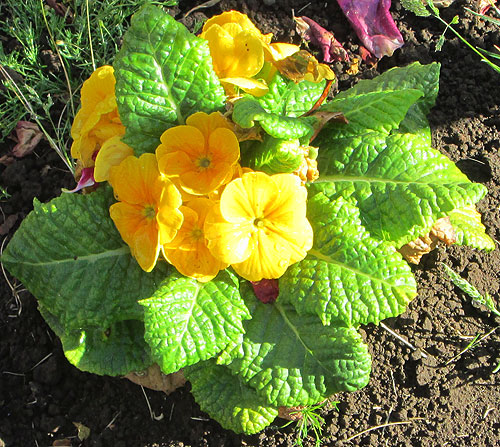 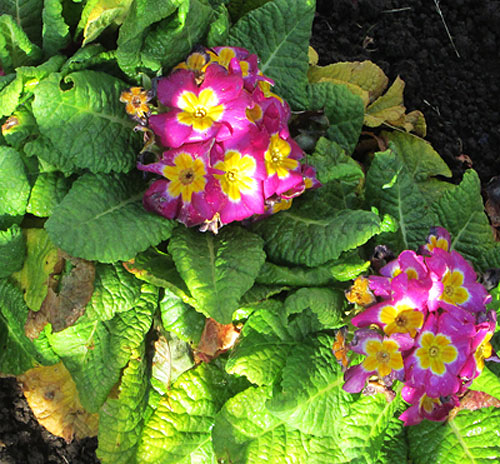 |
|||
**Pumpkin Cucurbita
maxima |
|||
|
|||
| Purple
Angelica, Korean Angelica, Giant Angelica, Purple Parsnip Angelica
gigas This perennial plant growing up to six feet in height could easily serve as a focal point in a garden bed. I found it striking and you may too. It blooms in the latter part of summer. Benefits: This plant is known to have been used in traditional Chinese medicine. From: Korea, China and Japan Photographed: Coastal Maine Botanical Gardens, Boothbay Maine, 2013. Planting and Care: This plant will do well in full sun or semi shade as long as it has moist soil. Text and Photographs ©GreenGardeningCookingCuring.com 2013/2018 |
|||
  |
|||
 **
Purple False Eranthemum Pseuderanthemum atropurpureum **
Purple False Eranthemum Pseuderanthemum atropurpureumThis is an unremarkable small bush with mottled grayish green and subdued purple leaves. We had it growing in the shade in what we call one of our plant parking lots, a shady place to put plants that we aren't yet ready to plant permanently elsewhere in the garden. This plant was proudly given to us by a garden assistant a few years ago and might have earned a better place had I known that the bush flowers, though it did not do so in the shade. Benefits: This is a butterfly attractant. From: The Pacific Islands Photographed: In our shady terrace garden at our former home in Montserrat. Planting and Care: Said to grow well in full sun to semi shade, I would have to say full sun did not seem a happy placement for this plant even after it had time to adjust to its move from a shady place. I think perhaps bright light would be best. It is happy with just a moderate amount of water and has in fact survived droughts when we were away for months at a time. Text and Photograph ©Krika.com 2009/2010 and ©GreenGardeningCookingCuring.com 2018 |
|||
| **Purple Horn of Plenty See the "Devil's Trumpets" Page -- DEVILS TRUMPET TREE | |||
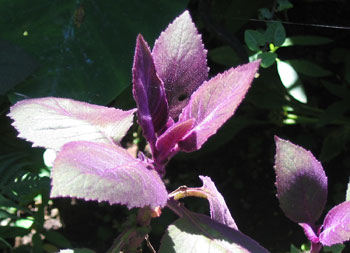 **Purple
Passion Plant, Velvet Plant, Purple Velvet
Vine Gynura aurantiaca **Purple
Passion Plant, Velvet Plant, Purple Velvet
Vine Gynura aurantiacaI found this furry purple plant in Panajachel growing outside and recalled having one as a houseplant when I was in college in Boston. I loved it then and still do. Benefits: I haven't found any medicinal benefits as of now. From: Southeast Asia and Java Photographed: In the Botanical Garden at the Hotel Atitlan on Lake Atitlan in Guatemala. Planting and Care: As a houseplant in New England Gynura aurantiaca does very well hung in a sunny window and watered when dry. It is not at all fussy. Outside in a warm climate, I would plant it in a morning sun spot in the garden and make sure that it receives rainfall or watering on a regular basis. Try to be careful about getting the leaves wet when watering as they can become unattractively spotted. Text and Photograph ©GreenGardeningCookingCuring.com 2013/2018 |
|||
| Purple
Sky Flower, Golden Dew Drop, Pigeon Berry, Skyflower Duranta
erecta 'Purple' Duranta erecta is a tall and wide growing somewhat undisciplined shrub that may reach a height of 20 feet with a spread also of about that size. Mature plants develop thorns that are absent on younger plants. Benefits: Butterflies and hummingbirds like these somewhat scruffy shrubs as much as we do. From: Mexico, South America and the Caribbean Photographed: In the Botanical Garden at the Hotel Atitlan on Lake Atitlan in Guatemala. Planting and Care: This is one of those flexible plants able to live well in full sun or partial shade and equally able to put its roots into sweet, acidic or neutral soils. Do remember that it is tropical in origin so it will not survive a freezing winter. Nor will I for that matter. Text & Photographs ©KO 2010 and ©GreenGardeningCookingCuring.com 2018 |
|||
  |
|||
|
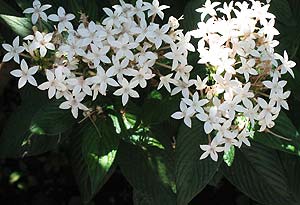



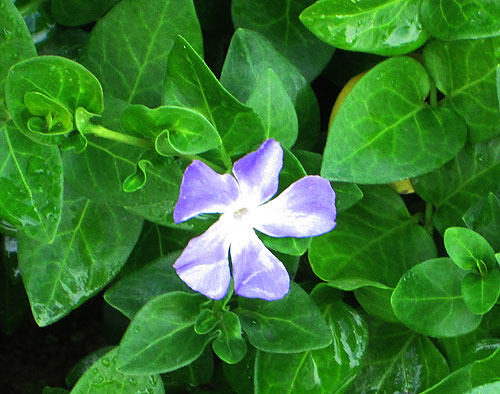

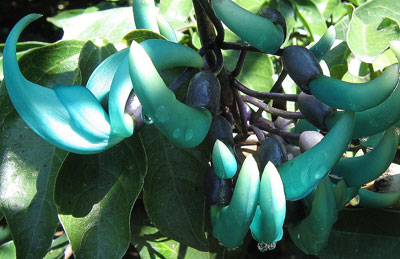
 top
of a pineapple, let it dry in the sun for a few days and then planted it. It
made a great potted patio plant, immune to all of Taxco’s bugs. After
a couple of years, it bloomed and then came a tiny pineapple. It grew and finally
ripened and we had our own fresh pineapple juice with a touch of rum to celebrate.
It was the most delicious pineapple we’ve ever eaten. We also grew a few
the same way in Montserrat, but sold our home there before the harvest. You might
also benefit from knowing that the Hawaiian and Mexican varieties are relatively
friendly plants. The Caribbean variety we had on Montserrat will shred your
skin in a heartbeat.
top
of a pineapple, let it dry in the sun for a few days and then planted it. It
made a great potted patio plant, immune to all of Taxco’s bugs. After
a couple of years, it bloomed and then came a tiny pineapple. It grew and finally
ripened and we had our own fresh pineapple juice with a touch of rum to celebrate.
It was the most delicious pineapple we’ve ever eaten. We also grew a few
the same way in Montserrat, but sold our home there before the harvest. You might
also benefit from knowing that the Hawaiian and Mexican varieties are relatively
friendly plants. The Caribbean variety we had on Montserrat will shred your
skin in a heartbeat.

